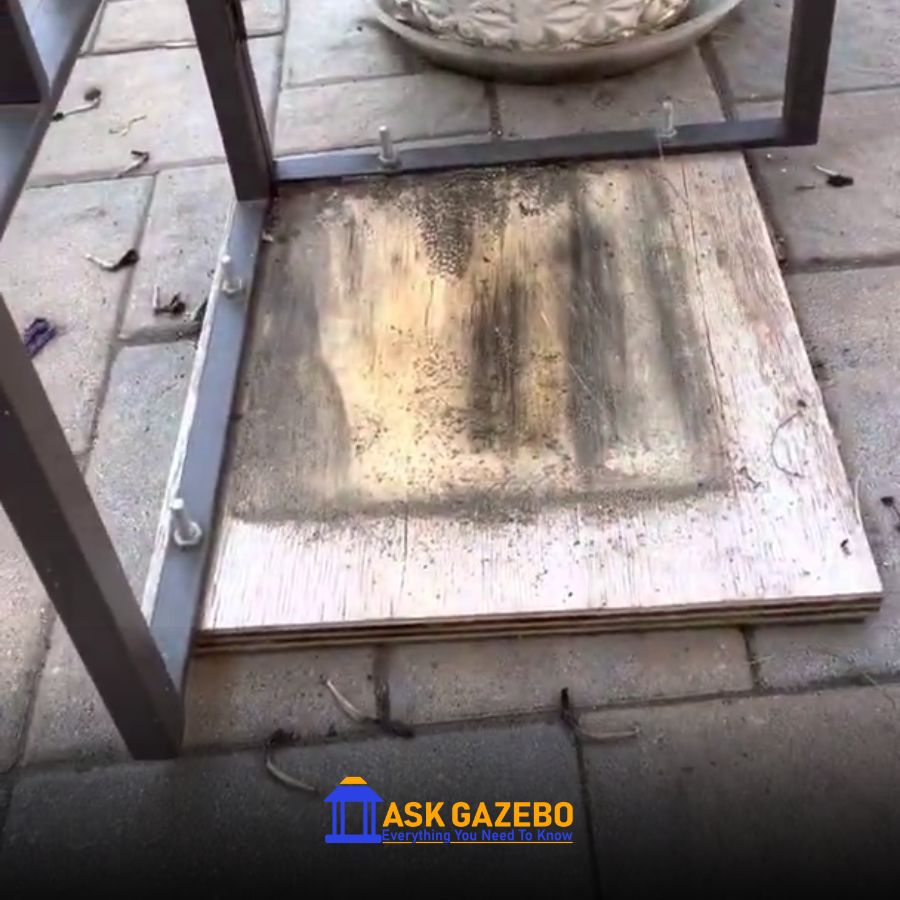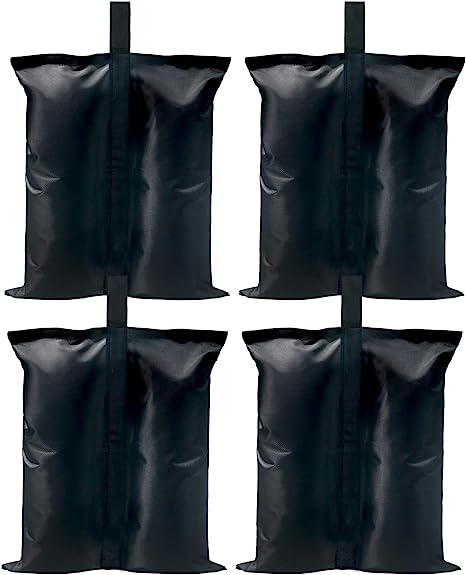Anchoring a gazebo to concrete is a primary step to ensure that your gazebo is secure and stable, especially if you live in an area with strong winds or inclement weather.
To do so, usually, we dig a hole into the concrete to fit the legs of the gazebo tightly or drill the heavy nuts into the concrete to secure the gazebo with the deck completely.
However, not everyone has the option or desire to drill into their concrete patio or deck. If you find yourself in this situation, do not worry. Some methods don’t require drilling into concrete.
In this article, we’ll look at a few of these options and walk you through the process of anchoring a gazebo to concrete without drilling.
Tools to anchor a gazebo without drilling:
There are several tools that you will need to anchor a gazebo to concrete without drilling. Here are some common tools that are required:


Weights or sandbags or bricks: If you decide to use weights or sandbags to anchor your gazebo, you will need a way to connect the weights or sandbags around the base of the gazebo. The weights or sandbags must to be secured using clips or other fasteners.
After finishing the work, you can place some decorations on these weights so that it does not look ugly.
Adhesive or epoxy: You will need a technique to apply the glue or epoxy to the gazebo and the concrete if you do not want to drill. To spread the epoxy or adhesive uniformly, you need to use a roller or other instrument and a caulking gun or spatula.
Base plate: A base plate is a great way to anchor the gazebo to concrete without drilling. For this, you will need a way to attach the base plate to the gazebo legs.


The base plate must be fixed to the gazebo frame using bolts or screws, or you can also use a unique mounting method according to your preferences.
Ground stakes or ground anchors: You will need a way to drive the ground stakes or anchors into the ground if you decide to anchor your gazebo to the concrete with them. Stakes or anchors need to be driven into the ground with a hammer or mallet.
Overall, the specific technique you chose will determine the specific tools required to anchor a gazebo to concrete without drilling.
Do you know How Far Should Gazebo Be From House?
Things to keep in mind while anchoring a gazebo to concrete:
To anchor your gazebo to concrete without drilling, keep these things in mind:
Choose the right method: Based on the unique requirements and conditions of your gazebo, it is necessary to select the appropriate method for anchoring your gazebo to concrete.
Take into consideration elements like the gazebo’s size and weight, the type of concrete surface you are working with, and the climate condition. For example, if you have a metal gazebo, then the method of placing a baseplate under it, and placing weights over it, will work fine for you.
Use proper safety measures: Wearing safety gear and adhering to the recommended tool usage guidelines are just a few ways to ensure your safety and the safety of others.
Test the stability of the gazebo: It is a good idea to test the stability of the gazebo to make sure it is firmly attached once you have secured it to the concrete. To check if the gazebo moves or feels unstable, you can gently push or pull on it.
If there is any movement or instability, you might need to modify your anchoring strategy or add more anchors to keep the gazebo in place.
Regularly check the anchors: The anchors you used to attach your gazebo to the concrete may deteriorate or come loose over time. Regularly checking the anchors is a good idea to make sure they are still firmly in place and that the gazebo is stable.


How to anchor a gazebo to concrete without drilling?
There are several methods that you can use to anchor a gazebo to concrete without drilling. Here are some options to consider:
Use weights or sandbags:
The use of weights or sandbags is one way to secure a gazebo to concrete without drilling. This technique will work well to maintain the gazebo in place, especially if it is a lightweight structure.
You will need weights or sandbags, as well as bungee cords or ropes to hold them in place. Sandbags should always be filled with sand or another heavy material before being placed around the gazebo’s base.


This kit provides ample weight to keep your gazebo securely anchored even in the high winds. The sandbags are also easy to fill and empty. We highly recommend this anchoring kit for almost every type of gazebo.
View On
Now, place the weights or sandbags properly spaced around the gazebo’s base to create a solid foundation.
Use clips or other fasteners to securely fasten the weights or sandbags in place, or secure them with bungee cords, ropes, or other attachments.
After you’ve secured the gazebo’s base with weights or sandbags, evaluate the stability of the structure by gently pushing or pulling on the gazebo.
Your anchoring technique is successful if the gazebo feels solid and stays in its fixed position. If there is any movement or instability, you might need to reposition the weights or sandbags or add more anchors to keep the gazebo in place.
Use a Base Plate:
Using a base plate is another alternative for securing a gazebo to concrete without drilling the concrete. To give a solid foundation to your gazebo, a base plate is a flat, strong surface positioned under the gazebo’s base.
You will need a base plate for this as well as any additional items necessary to attach the base plate to the gazebo, such as bolts or screws.
You need to use bolts, screws, or a unique mounting system to attach the base plate to the gazebo bottom, depending on the specific designs of the base plate and the gazebo.


Place the base plate on the concrete surface after it has been connected to the gazebo. Verify that the base plate is level and that the concrete is properly supporting it.
When you successfully install the base plate, you can add weight over it. It will make your gazebo stable and well-anchored to the concrete without drilling into it.
Use Adhesive or Epoxy:
Epoxy or adhesive can also be used to fix a gazebo to concrete without the need for drilling. If the gazebo is relatively lightweight and the glue or epoxy is properly applied, this method is quite effective.
You will need adhesive or epoxy, as well as a caulking gun or spatula, to apply it. To make sure you have all the required supplies, be sure to follow the instructions that came with the adhesive or epoxy.
Before applying the adhesive or epoxy, it is important to clean the concrete surface to ensure that it is free of dirt, debris, or other contaminants. After cleaning the surface with a brush or a dustpan, use a moist cloth or a mild cleanser to wipe it off.
Use a caulking gun or a spatula to apply the adhesive or epoxy to the concrete surface and the bottom of the gazebo after the concrete has been well-cleaned.


Once you have poured sufficient adhesive under the legs of your gazebo, let it dry. While it is drying, make sure there isn’t any movement to your gazebo as it can affect its grip on it.
If you do all this right, and your gazebo isn’t much heavy, this method will work great for most of the situations. If you found it a loose foundation, you can add some weight to it.
Use ground stakes or ground anchors:
Another method for anchoring a gazebo to concrete without drilling is to use ground stakes or. If the gazebo is reasonably lightweight and the ground anchors are properly put, this method works well to maintain the gazebo in place.
To install them, you’ll need a hammer, as well as ground stakes or ground anchors. Use a hammer to drive the ground pegs or anchors you placed around the gazebo’s base into the concrete.
Once the ground stakes or ground anchors are installed, use bungee cords or ropes to secure the gazebo to the stakes or anchors. By doing this, you can assure that the gazebo doesn’t move or tip over.
Use ground pegs or ground anchors to secure the gazebo to the concrete. Then, evaluate the gazebo’s stability by gently pushing or pulling on it.


Subscribe For More Gazebo Videos!
Ask Gazebo
Benefits of anchoring the gazebo to concrete without drilling:
Here are several benefits to anchoring a gazebo to concrete without drilling:
No damage to the concrete:
One benefit of anchoring a gazebo to concrete without drilling is that it can help avoid damaging the concrete. Although concrete is a sturdy and long-lasting substance, it is not unbreakable. It is difficult to repair holes drilled into concrete, especially if the holes are large or deep.
This could be a problem if you want to take down the gazebo in the future or if you just want to keep your concrete patio or deck looking good.
You can utilize the above methods like anchoring the gazebo with weights or sandbags or attaching it to the concrete with glue or adhesive to prevent any damage to the concrete.
These techniques don’t involve drilling into the concrete but are super effective if you have done it right.
No need for special tools:
Another benefit of anchoring a gazebo to concrete without drilling is that it can save you the time and effort of using specialized tools. The most common method for drilling into concrete is to utilize a hammer drill, a string instrument made especially for the job.
Although hammer drills can be useful for drilling holes in concrete, they can also be heavy and challenging to operate, especially if you are not used to using them.
You can save money by anchoring your gazebo without using a hammer drill and its related specialty bits by choosing an alternative approach.
Additionally, you won’t have to bother about paying for or renting the drill, which might be expensive if you just need it once.
So, yes, securing a gazebo to concrete via a different technique can be simple and affordable without the need for specialist equipment.
Quick and easy installation:
Some non-drilling techniques for anchoring a gazebo to concrete can be quickly and easily installed by one person. Compared to drilling into the concrete, which can be a more time-consuming process.
For instance, you can anchor the gazebo with weights or sandbags, which can be quickly and simply placed around the gazebo’s base. Alternately, attaching the gazebo to the concrete can be accomplished fast and easily by using epoxy or adhesive.
Yes, alternative techniques for anchoring a gazebo to concrete can be installed fast and easily, which can be a huge benefit if you’re pressed for time or just want to have the gazebo up as soon as possible.
More versatility:
You might set up the gazebo on different surfaces, such as grass or soil, by using some alternate techniques for securing it to concrete, such as using weights, sandbags, ground stakes, or ground anchors.
As a result, you have more options for where to put your gazebo and be able to erect it in locations where drilling into the concrete might not be possible or acceptable.
For example, if you want to set up your gazebo in a grassy area, you could use ground stakes or ground anchors to secure it to the ground. These techniques don’t need a strong foundation and can be just as effective at holding the gazebo in place as drilling into concrete.
Similar to how you could use weights or sandbags to anchor your gazebo, you could do the same if you wanted to set up your gazebo on a patio or deck constructed of something other than concrete, like wood or brick.
Potential cost savings:
It is less expensive to use non-drilling anchoring techniques for gazebos than to buy and use specialist equipment for drilling into concrete.
For instance, since these items are frequently inexpensively available, utilizing weights or sandbags to secure the gazebo can be a relatively economical choice.
Similarly, securing the gazebo to the concrete with adhesive or epoxy might also be a budget-friendly choice, especially if you already have these supplies on hand.
However, drilling into concrete frequently necessitates the use of specialist equipment, such as a hammer drill and related bits. Renting or buying these items might be pricey, especially if you only need to use them once.
So, if you are on a limited budget or simply want to save money on the installation procedure, the potential cost savings of various ways for anchoring a gazebo to concrete might be a significant benefit.
Dealing with sloped concrete? Learn: How To Level Gazebo On Sloped Concrete.
FAQs
Can I anchor a heavy gazebo to concrete without drilling?
It is possible to anchor a heavy gazebo to concrete without drilling, but it will be more challenging than anchoring a lightweight gazebo.
You should pick the ground anchoring method to do so. However, it need some tools to do so.
Consult a professional or follow to the directions given by the maker of your gazebo if you’re unclear on how to securely fasten a hefty gazebo to concrete without drilling.
How often should I check the anchors for a gazebo that is anchored to concrete?
It is generally a good idea to check the anchors for a gazebo that is anchored to concrete on a regular basis to ensure that it is securely in place. You can build a habit of checking the anchor once a month for a longer lifespan of your gazebo.
How do I test the stability of a gazebo that is anchored to concrete?
To check the stability of the gazebo, gently push or pull on it. The anchoring is probably strong if the gazebo feels secure and stays put.
It’s possible that the anchors are insufficient or improperly set if the gazebo seems unstable or moves when you push or pull on it.
To secure the gazebo in this situation, you might need to move the anchors around or add more anchors.
How to install a gazebo without drilling into concrete?
If you are installing your gazebo for the first time, take your time and explore the above methods and pick up one that suits your requirements and area.
For example, if you are installing a lightweight gazebo in an area where high-speed winds are common, go with the base plate method with extra weight over it.
Do you know How to Decorate a Pop Up Gazebo?
Conclusion:
In summary, there are a number of non-drilling techniques that can be used to secure a gazebo to concrete, including the use of weights or sandbags, a base plate, adhesive or epoxy, ground stakes, or ground anchors.
When selecting the appropriate method to anchor gazebo without drilling into concrete, it is crucial to carefully analyze the unique requirements and circumstances of your gazebo because each of these methods has unique advantages and disadvantages.
Additionally, it’s crucial to confirm that the anchors are properly set up, that the gazebo is firmly fastened, and to regularly check the stability of the gazebo to guarantee its security and safety.








